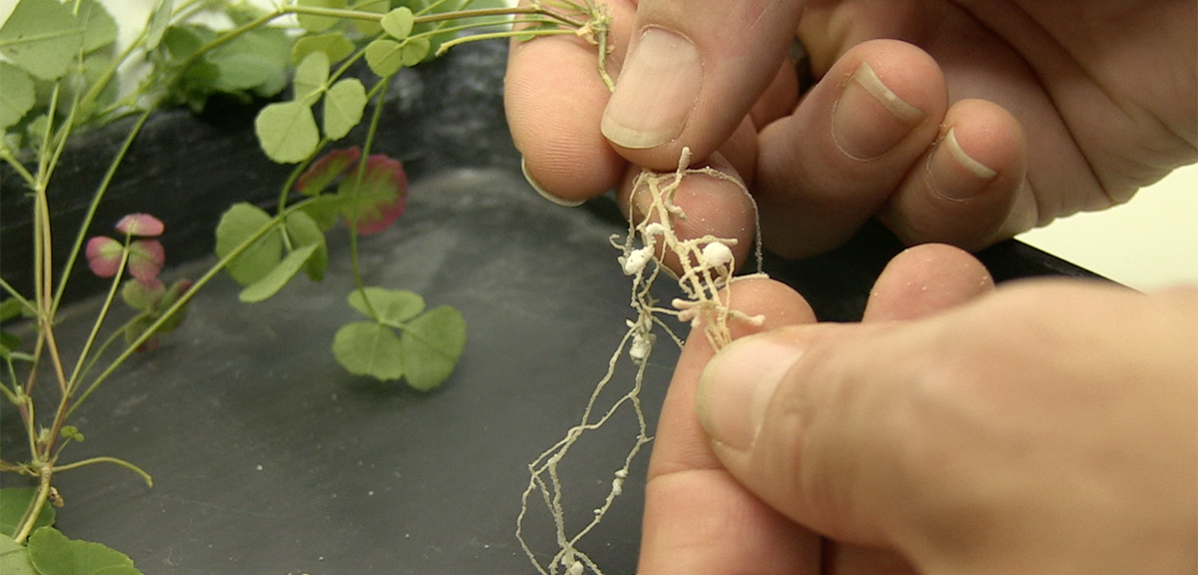You are here
All plants need light, carbon dioxide, water and nutrients to grow. Light and air are widely abundant and easily accessible resources. Nutrients on the other hand are drawn from the soil, which only has a limited supply.
One of these vital elements is nitrogen.
Here at the Moulon Farm, an agricultural experiment is being conducted. The aim is to determine what optimal quantity of nitrogen is to be provided to a wheat field.
ITV Didier Tropée, Research Technician
A plant which has been well nourished, and a plant which has suffered. This plant received enough nitrogen, and this one hasn’t. We didn’t go over it with the fertilizer spreader. It’s lighter, with stunted growth. Here you can see that a head is growing, while it will take much longer for the other one.
Grains, like wheat and corn, suffer if they lack nitrogen fertilizers. But when these fertilizers are over-used, they pollute the soil and rivers. Other plants can easily thrive without them. At the Institute for Integrative Biology of the Cell, in Southwest Paris, researchers are studying plants that have developed a clever strategy to tap into the nitrogen from the atmosphere…
ITV Benoit Alunni, Biologist 10s
So, in the past we worked more on alfalfa, but more recently, we’ve introduced other models like peas, and even more recently aeschynomene (pronunciation : http://www.pronouncekiwi.com/Aeschynomene), which are tropical plants.
If the soil nitrogen levels run low, these plants known as pulses don’t need to rely on farmers. They turn to another supplier: bacteria.
ITV Benoit Alunni, Biologist
The soil bacteria they are in contact with will metabolize atmospheric nitrogen, 78% of what we breathe. They fix this nitrogen then and transfer it to the plant. Plants can’t metabolize atmospheric nitrogen on their own. So these pulses have found, through these bacteria, easy access to a huge quantity of nitrogen, which other plants can’t use.
All pulses function roughly the same way. When the soil is poor, the plant sends signals from its roots. These signals attract rhizobia, bacteria able to fix atmospheric nitrogen.
After a short chemical dialogue between the plant and the rhizobium, the root infection process starts and the pulse even creates specific organs to receive its new guests…
ITV Benoit Alunni, Biologist
We call these organs nodules, and in these nodules, the bacteria will be lodged inside plant tissue. They will transform the atmospheric nitrogen into nutrients the plant can use and, in exchange, the plant will provide the bacteria with carbon-based molecules produced from photosynthesis.
Carbon in return for nitrogen. The transaction seems fair. But the plant must be careful not to befriend any type of rhizobium.
ITV Benoit Alunni, Biologist
Here, we have plants of the same variety, same species. By inoculating them with two different types of bacteria, we get a very different effect. In one case, the symbiosis is effective. We see that the plant considerably benefits from interacting, it develops much better. It forms much more biomass, whereas here, the interaction doesn’t functions as well, it’s much less effective. We see that this bacterial strain hasn’t really allowed the plant to develop properly.
Here we are in a laboratory situation and the researchers forced a certain nitrogen supplier on the plant. But in more natural conditions, it is a whole different story – there is no monopoly by a single bacterial strain – and so the plant can chose from the competition.
ITV Benoit Alunni, Biologist
Plants are able to control part of this interaction, especially the return on investment from the carbon given and nitrogen recovered. So, plants are able to distinguish between highly effective bacteria and bacteria that are not very effective or totally ineffective. Depending on this, they will sanction the cheats and promote the co-operators which give the most nitrogen.
This nitrogen / carbon market is not as free as it seems. Once the plant has selected its productive bacterial partner, the relationship shifts towards a form of domestication or farming. The plant produces proteins which transform the bacteria into nitrogen supplying machines.
ITV Benoit Alunni, Biologist
These bacteria have a certain shape, a certain size in the environment. When we find them inside plants, their form has completely changed. They will be longer and will have increased their DNA content. These are very fundamental mechanisms in biology. We study them to see how the plant forces the bacteria to change shapes, and change their metabolism. They go from bacteria that live in the soil and eat and produce all kinds of things, to bacteria with the single task of fixing nitrogen over and over again. They end up being extremely efficient at fixing nitrogen.
These proteins which allow plants to modify bacteria have already been isolated for therapeutic purposes in humans. The research on this complex symbiosis also points to a future where more nitrogen in farming may come from the air rather than fertilizers.
With the participation of
Moulon Farm
University Paris-Sud
Image and sound
Journalists
Juliette Lacharney and Cécile Khindria
Editing
Mixing
Editor-in-Chief
Archive images
Nodules and bacteria in confocal microscopy
Rhizobium
All rights reserved
A CNRS IMAGES production
Bacteria-Taming Plants
To grow, plants need nutrients that they draw from soil, especially nitrogen. Pulse crops (the UN declared 2016 the International Year of Pulses (IYP)) have developed a cunning strategy: they partner up with bacteria able to metabolize nitrogen directly from the atmosphere. Researchers are very interested in this phenomenon, and hope to apply it to develop therapeutic applications or use atmospheric nitrogen in agriculture.
Ferme du Moulon
INRA
Benoit Alunni
Théophile Kazmierczak
Institute for Integrative Biology of the Cell (I2BC)
CNRS / CEA / Université Paris Sud





